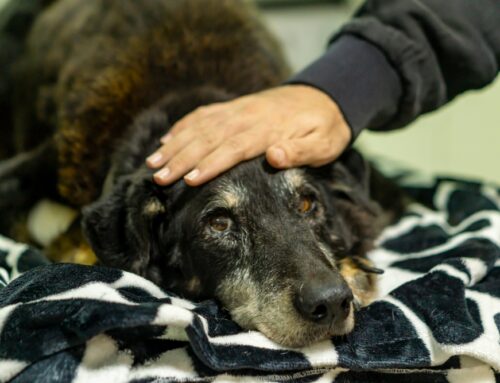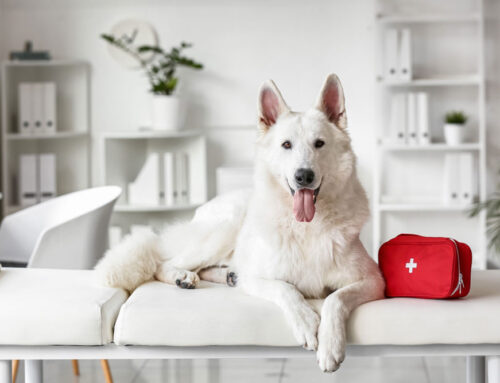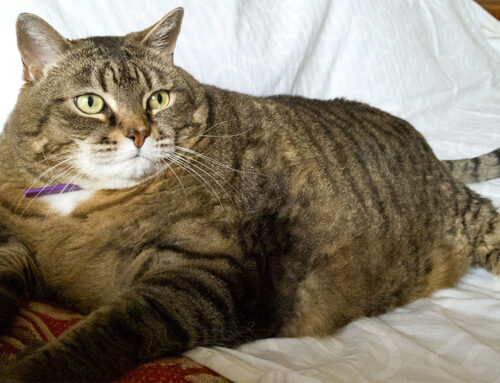Calming the Chaos: How to Help Dogs and Cats Overcome Anxiety
Your dog trembles during storms. Your cat hides the moment you bring out the suitcase. Maybe your pet chews furniture when left alone or refuses food after a big household change.
These are not signs of disobedience- they’re symptoms of anxiety.
At Bayview Animal Hospital, we know how deeply stress affects a pet’s physical and emotional health. Our veterinarians take a comprehensive approach to diagnosing anxiety, using advanced medical tools, behavioral insight, and therapies such as laser treatment to restore comfort and confidence. Helping pets manage anxiety improves their quality of life- and strengthens the connection they share with you.
Understanding Anxiety in Pets
Anxiety is more than occasional nervousness. It’s an emotional and physiological response that can alter how pets behave, sleep, and interact. Because pets can’t tell us how they feel, their body language and habits are the best clues.
Why Pets Develop Stress and Anxiety
Anxiety has many potential causes, often overlapping between emotional and medical factors.
- Environmental triggers: Noise aversion from fireworks, thunderstorms, or nearby construction is a common cause. Even subtle sounds- like ceiling fans, alarms, or slamming doors- can overwhelm sensitive pets.
- Social stress: Routine changes, new family members, or time alone can unsettle pets that rely on predictability.
- Physical discomfort: Pain or illness often hides behind anxiety-like behavior. Arthritis, dental pain, or digestive disease can cause pacing, restlessness, or irritability. For older pets, cognitive dysfunction– similar to dementia- can lead to confusion, new fears, or nighttime agitation.
When anxiety is persistent, it can weaken the immune system, disrupt digestion, and lead to destructive or self-harming behavior. Early veterinary assessment helps determine whether the cause is medical, behavioral, or both.
Recognizing the Signs of Anxiety
Behavioral and Physical Indicators
Anxiety can appear in many forms.
Dogs may pant excessively, shake, pace, spin, or bark nonstop. Some show signs of separation anxiety- destroying objects or losing bladder control when alone.
Cats may hide, overgroom, or refuse to eat. Changes in litter box habits and sudden aggression are also common. Many cat behavior issues are not defiance, but the visible signs of stress.
Reading Body Language
Your pet’s posture often reveals how they’re coping. Canine body language such as lip licking, yawning, crouching, or a tucked tail shows tension. For cats, body cues like flattened ears, wide eyes, or stiff movements suggest fear or unease.
The feline grimace scale helps identify when facial tension signals pain rather than emotional stress. Recognizing these early signs allows you to respond with empathy and avoid escalation.
When in doubt, document your pet’s behavior patterns- when anxiety occurs, what triggers it, and how long it lasts. These notes help your veterinarian pinpoint causes and track progress once treatment begins.
What Triggers Anxiety in Pets
Noise-Related Fears
Sound sensitivity is one of the most common reasons pets develop anxiety. Thunder, fireworks, or even heavy traffic can cause panic, shaking, or escape attempts. Some pets react before a storm begins due to pressure and static changes in the atmosphere.
To help, create a quiet, safe room with soft music, dim lighting, and comfortable bedding. Reward calm behavior, and consider sound-desensitization exercises to build tolerance over time. For severe cases, your veterinarian may recommend medication during noise-heavy seasons or major holidays.
Changes in Routine or Environment
Pets thrive on consistency. A move, new furniture, or changes to your work schedule can lead to stress. Cats are especially sensitive to environmental shifts and may stop eating or grooming when unsettled.
Dogs often struggle with separation anxiety, showing distress through excessive barking or destructive chewing shortly after you leave.
In multi-pet homes, tension among cats or reactive behavior in dogs can develop when social space feels limited. Some pets even begin resource guarding food, toys, or favorite resting spots when anxious.
Recognizing these patterns helps prevent conflicts and keeps the household harmonious for both pets and people.
Helping Pets Feel Calm Again
Behavioral and Confidence Training
Behavior modification gives pets the tools to manage fear safely. Positive reinforcement teaches calm behaviors through praise and reward instead of punishment.
Games such as the engage–disengage training game help dogs practice self-control and learn that triggers don’t have to be frightening.
For routine care and handling, cooperative care training for dogs and for cats teaches pets to participate willingly in exams, grooming, and nail trims- reducing fear and building trust.
Training works best when consistent, gradual, and positive. Even a few minutes of calm practice each day can help rewire a pet’s emotional response to stressful experiences.
Environmental Enrichment
Mental stimulation and structured activity are essential for anxious pets.
- For cats: Enrichment toys, window perches, and indoor enrichment setups provide safe outlets for natural hunting and climbing instincts. Encourage play that mimics prey behavior, such as wand toys or treat puzzles, to build confidence.
- For dogs: Dog enrichment ideas like puzzle feeders, hide-and-seek games, and sniffari walks reduce boredom-based anxiety.
For older or arthritic pets, comfortable bedding and laser therapy can reduce pain, helping them relax and move more easily. Exercise and gentle stretching keep muscles limber and prevent stiffness from amplifying stress.
Even small environmental improvements- predictable feeding times, consistent sleep routines, and calm spaces away from loud activity- can help pets feel safe and balanced.
Veterinary and Medical Support
Some pets benefit from calming supplements, prescription medications, or pheromones that create a sense of safety.
At Bayview Animal Hospital, we customize treatment based on your pet’s medical history and lifestyle. Our diagnostic capabilities- including in-house blood, urine, and imaging tests- help us identify any health issues contributing to anxiety. For chronic pain or arthritis, laser therapy provides gentle, noninvasive relief that supports both physical comfort and emotional calm.
For pets with long-term anxiety, we may design a combined plan that includes medication, enrichment, and structured training sessions to address every layer of the problem. Our goal is to help pets feel better- not just behave better.
Working With Your Veterinarian
Bringing an anxious pet to the clinic can feel daunting, but preparation helps. Practice calm car rides, use pheromone sprays, and bring familiar items from home to ease the transition. You can also make veterinary visits less stressful by letting our team know your pet’s triggers ahead of time.
Bayview Animal Hospital’s gentle handling approach prioritizes patient comfort. Our veterinarians may recommend pre-visit medications or specific scheduling adjustments to make exams smoother for anxious pets.
Comprehensive Evaluation
Our diagnostic process includes physical exams, behavioral history, and advanced lab testing to distinguish anxiety from underlying medical problems. Early detection ensures faster, more effective treatment and helps prevent unnecessary suffering.
Explore our full list of services or contact us to schedule an exam tailored to your pet’s needs.
Common Misconceptions About Pet Anxiety
- “They’ll grow out of it.” Without support, anxiety usually becomes more severe over time.
- “It’s just bad behavior.” Fear or discomfort is often at the root of destructive or avoidant actions.
- “Medication means failure.” In some cases, medication gives pets the balance they need to learn and heal.
- “Just tell them no.” Punishment does not help anxious pets; instead, it teaches them that you won’t listen to their communication, and can actually make behaviors worse. If you don’t listen, they’ll just speak louder through their actions.
Helping Your Pet Feel Calm, Confident, and Loved
Anxiety doesn’t have to control your pet’s life- or yours. With patience, training, and veterinary care, most anxious dogs and cats can learn to feel secure again.
At Bayview Animal Hospital, our team believes in caring for pets “the right way”- with empathy, modern medicine, and the same dedication we give our own animals. Whether your pet’s stress is new or ongoing, we’ll help uncover the cause and guide you toward lasting relief.
Call (727) 477-1442 or request an appointment online today to start your pet’s path toward peace and comfort.








Leave A Comment